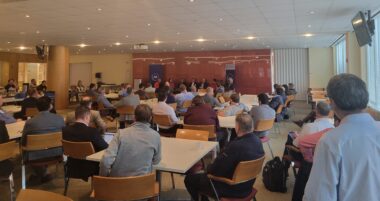A Pioneer in Automation Becomes a Champion for Digital Transformation
Rockwell Automation’s history points to a pioneering drive to make machines smarter. From its 1903 founding as the Compression Rheostat Company, soon to be renamed the Allen-Bradley Company, the company started with an early prototype machine controller and  is now a world leader in digital transformation – both for its own operations and in offering guidance for its customers. Today, Rockwell is a $9 billion company with nearly 29,000 employees serving customers in 100 countries.
is now a world leader in digital transformation – both for its own operations and in offering guidance for its customers. Today, Rockwell is a $9 billion company with nearly 29,000 employees serving customers in 100 countries.
In early April, a group of Manufacturing Leadership Council members toured Rockwell’s electronic assembly plant in Twinsburg, Ohio, just outside of Cleveland. The theme of the tour was “Build a Digital Transformation Culture with MES and IoT Technology.” The 250,000-square-foot Twinsburg plant is one of four main electronic assembly locations within Rockwell that provide printed circuit board assemblies that go into the company’s products, with Twinsburg’s eight surface mount technology lines placing three million components and forming 11 million solder joints to make 3,000 control panels each day.
Rockwell’s manufacturing operations is regarded by many as a role model for system integration and data analytics. The company monitors and integrates its engineering data, material management data, product error proofing and genealogy, machine data, quality data, waste data, and performance data. Data is delivered to where it is most relevant and impactful, from facility performance to team leaders down to the specific work order and line performance for operators.
The company utilizes its FactoryTalk production system, industrial automation software that was developed to streamline processes while improving precision and reducing errors. It creates an interactive platform that can integrate data visualization, data collection and analysis, process design, and system diagnostics. Rockwell offers a full suite of FactoryTalk products, including for analytics and data management, product and process design, human-machine interface, industrial communications, maintenance, performance monitoring, and more.
Additionally, Rockwell utilizes a closed loop operating system that combines scheduling and constraint management, and automatically enforces finite capacity based on, for example, the number of operators available at the plant on a given day. Company leaders say this system has helped to eliminate some of its functional siloes, as its development was collaborative and cross-functional, with many different teams giving input to create a tool that could benefit all. While FactoryTalk is already available for manufacturers to license at their own facilities, Rockwell has an eye toward commercializing its closed loop operating system as well.
The tour didn’t shy away from showing both Rockwell’s tried-and-true technologies in addition to its newer ones, including a robot for final testing and assembly that utilizes a digital twin and AR to train operators and maintenance technicians. The machine is being used to create robot standards that can be scaled elsewhere throughout its other manufacturing facilities. At the time of the tour, it had been on the factory floor for less than eight weeks.
When Rockwell’s operations leaders were asked the top reasons for starting their digital transformation journey, they mentioned a need to address a huge uptick in demand, high turnover in the workforce that has led to far less tribal knowledge among frontline operators, and a desire to improve constraint management – both identifying and resolving those constraints. Looking toward the future, the company wants to capitalize on the momentum it has established on its digital transformation journey, explore the opportunities presented by AI and generative AI, and operate on the basis of real-time data-driven decisions.
Rockwell’s leaders also pointed to culture as key to getting functions and teams to work together while moving forward on technology transformation. When it comes to dealing with the complexity created by working with multiple layers of software, they think of it the same way as they do when developing their own products – take things that are sophisticated and make them easy to use by designing them for an operational environment.
Never one to shy from innovation, Rockwell is looking to an exciting future of possibilities ranging from developing large language learning models for manufacturing to building industrial ecosystems to creating a comprehensive data loop that moves between customers, engineering, and manufacturing. It seems fitting for a company that has placed itself as a cutting-edge leader from the radio age to the space age to the data age.
Read a full interview with Rockwell CEO Blake Moret here.